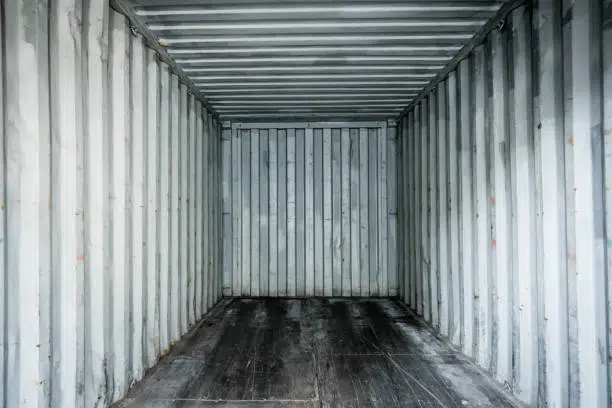Moisture buildup inside shipping containers is a common issue that can lead to significant damage to cargo. Understanding the causes of moisture accumulation and implementing effective preventive measures is crucial to ensure the safety and integrity of your goods. This guide will delve into the various strategies and solutions to protect your cargo from moisture, ensuring that your shipping containers are optimized for any climate or condition.
What Causes Moisture to Build Up in Shipping Containers?
Moisture can accumulate in shipping containers due to several factors. The primary cause is the difference in temperature between the inside and outside of the container, leading to condensation, commonly known as “container rain.” This is particularly prevalent in containers that are not adequately ventilated or insulated.
Factors contributing to moisture buildup include:
- Temperature Fluctuations: When containers move through different climates, the external temperature changes can cause the air inside the container to reach its dew point, resulting in condensation.
- Humidity Levels: High humidity, especially in tropical or coastal regions, can introduce excess moisture into the container, increasing the risk of condensation.
- Poor Ventilation: Lack of adequate airflow prevents moisture from escaping, causing it to accumulate inside the container.
- Cargo Moisture Content: Some goods, especially perishables or those with a high moisture content, can release moisture during transit, contributing to overall humidity inside the container.
- Seawater Exposure: Shipping containers used in maritime transport are frequently exposed to seawater spray and high levels of ambient humidity. This exposure can lead to higher moisture levels inside the container, particularly if the container is not adequately sealed.
- Improper Cargo Packing: When cargo is packed too tightly or without adequate air gaps, it can restrict airflow within the container, leading to trapped moisture. This is especially problematic when transporting goods with inherent moisture content, such as fresh produce or damp materials.
Understanding these causes is the first step toward preventing moisture-related damage to your cargo.
The Damaging Effects of Moisture on Cargo
Moisture can cause significant damage to cargo, particularly when left unchecked over long periods. The consequences of moisture accumulation inside shipping containers include:
- Corrosion: Metals and machinery are especially vulnerable to rust and corrosion when exposed to moisture, leading to potential operational failures.
- Mold and Mildew: Organic materials, such as textiles and paper, can develop mold and mildew, causing degradation, unpleasant odors, and health risks.

- Warping and Swelling: Wooden products and furniture can warp or swell due to moisture, leading to irreversible damage and making them unsuitable for use.
- Product Spoilage: Moisture can lead to the spoilage of food items and other perishables, resulting in significant financial losses.
- Electrical Equipment Failure: Moisture can seep into electrical components, causing short circuits, corrosion, and complete failure of electronic systems. This can be particularly disastrous for high-value equipment, leading to costly replacements and operational downtime.
- Reduced Structural Integrity: Moisture exposure can weaken the structural integrity of certain materials, such as cardboard, paper, and some textiles. This deterioration can cause packaging to fail, leading to product damage and increased handling risks.
These effects underscore the importance of taking proactive steps to control and eliminate moisture within shipping containers.
Effective Ventilation Strategies to Prevent Moisture
Proper ventilation is a crucial defense against moisture buildup in shipping containers. Implementing effective ventilation strategies can help maintain airflow and prevent condensation.
- Installing Vents: Adding vents to the container allows for continuous airflow, reducing humidity levels and the risk of condensation. Vents are particularly effective for containers used in high-humidity regions or for storing moisture-sensitive cargo.
- Natural Ventilation: Positioning containers in a way that maximizes natural airflow can also help reduce moisture accumulation. This method is especially useful in temporary or short-term storage situations.
- Mechanical Ventilation: For containers in environments with extreme temperature fluctuations, mechanical ventilation systems can provide controlled airflow, ensuring that moisture levels remain low.
- Solar-Powered Ventilation Fans: Installing solar-powered fans can enhance air circulation within the container without relying on external power sources. These fans are particularly effective in maintaining airflow in remote or off-grid locations, reducing the risk of moisture buildup in storage shipping containers.
- Cross-Ventilation Systems: Implementing a cross-ventilation system involves strategically placing vents on opposite sides of the container. This setup allows for natural air exchange, which is essential in high humidity environments where moisture is more likely to accumulate.
How Desiccants Can Protect Your Cargo from Moisture
Desiccants are an effective tool for absorbing moisture inside shipping containers, particularly for goods that are highly sensitive to humidity.
Silica Gel Packs: These are commonly used in smaller containers or packages to absorb moisture and keep the environment dry.
 Container Desiccant Bags: These larger desiccants are designed for use in shipping containers and can absorb significant amounts of moisture over long periods.
Container Desiccant Bags: These larger desiccants are designed for use in shipping containers and can absorb significant amounts of moisture over long periods.
Clay Desiccants: A cost-effective option, clay desiccants can be used for larger cargo shipments where silica gel may not be sufficient.
Calcium Chloride Desiccants: Known for their high moisture absorption capacity, calcium chloride desiccants are ideal for shipping containers used in long-term storage or transporting goods through humid regions. These desiccants can absorb moisture up to several times their weight, making them a cost-effective solution.
Reusable Desiccants: For more environmentally conscious operations, reusable desiccants offer a sustainable option. These can be dried and reused multiple times, providing a long-term solution to moisture control in containers without the need for continuous replacement.
Using desiccants is a simple yet effective way to mitigate the risks of moisture damage, especially when combined with other moisture control measures.
Insulation: A Key Defense Against Moisture
Insulation is another critical factor in preventing moisture accumulation in shipping containers. By maintaining a consistent internal temperature, insulation reduces the likelihood of condensation.
- Spray Foam Insulation: This is a popular choice for its ability to create a moisture-resistant barrier while also providing thermal insulation.
- Insulated Panels: These panels can be installed inside the container walls to help regulate temperature and prevent condensation.
- Reflective Insulation: This type of insulation reflects heat away from the container, reducing internal temperature fluctuations and minimizing the risk of moisture buildup.
Proper insulation is particularly important for containers that store temperature-sensitive goods or are exposed to extreme weather conditions.
Climate Control Options for Shipping Containers
For goods that require strict temperature and humidity control, integrating climate control systems within shipping containers is essential.
- Refrigerated Containers: These are ideal for perishable goods, providing precise temperature control and reducing moisture-related risks.

- Dehumidifiers: Installing dehumidifiers inside the container can actively remove excess moisture from the air, maintaining optimal humidity levels.
- Air Conditioning Units: For containers used as living spaces or offices, air conditioning units can provide both temperature and humidity control, ensuring a comfortable and safe environment.
These climate control options ensure that your cargo remains in the best possible condition, regardless of external weather conditions.
Additional Tips for Preventing Moisture Damage
Preventing moisture damage requires a multifaceted approach, combining ventilation, insulation, and climate control with good cargo management practices.
- Regular Inspections: Conduct regular inspections of your containers to check for any signs of moisture buildup, such as condensation or mold.
- Proper Loading Techniques: Ensure that cargo is loaded in a way that allows for airflow around all sides, reducing the risk of moisture being trapped.
- Use of Pallets: Elevating cargo off the floor using pallets can prevent moisture from seeping into the goods from the container floor.
- Seal Integrity: Regularly check and maintain the seals on your container doors to prevent moisture ingress during transport.
By following these tips and strategies, you can significantly reduce the risk of moisture damage to your cargo.
Protect Your Cargo with Moisture Prevention Strategies
Preventing moisture accumulation in shipping containers is vital to protecting your cargo and ensuring successful delivery. By understanding the causes of moisture buildup and implementing the right strategies, such as effective ventilation, using desiccants, insulation, and climate control, you can safeguard your goods against moisture-related damage. For reliable and high-quality shipping containers that meet all your project needs, whether for short-term or long-term use, Port Shipping Containers offers a wide range of sizes and customization options. Contact us today to learn more about our competitive prices and exceptional customer service.









